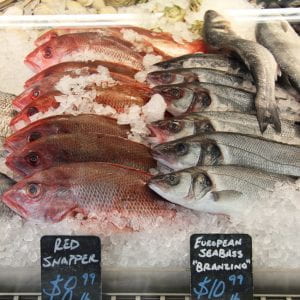You’ve heard about the bait and switch in your dating apps, but have you considered it at your favorite seafood restaurant?
Photo courtesy of Boston Magazine.
Fish and other seafood are major sources of nutrition for much of the world’s population. The United States is behind China as the second largest consumer of seafood worldwide. More than 90% of the seafood consumed by the United States is imported (3), and just 2% of it is inspected annually (2). Oceana conducted a major study in 2013 using DNA analyses to examine the accuracy of seafood labeling in various markets. The study collected samples from a range of grocery stores and restaurants across the country in 21 different states. This study found that of the 1,215 samples analyzed, 33% were mislabeled (4). The study relaunched in 2018 to determine whether the issue still persists and found that it does – with 21% of the 449 samples mislabeled(5). While the rate has decreased, the issue is proven to still be prevalent.
Chart courtesy of Oceana.
Red Snapper had one of the highest rates of mislabeling of all the fish species examined at 87% mislabeling. Of all the specimens labeled as Red Snapper examined, 28 different species of fish were identified during the DNA analysis. Seventeen of which didn’t even fall into the snapper family (4).
Chart courtesy of Oceana.
Overall, restaurants were found to have higher rates of mislabeling at 38%, than grocery stores at 18%. Sushi venues in particular had a mislabeling rate at a staggering 74% (4). Another 2017 study by UCLA looked at mislabeling in sushi restaurants in Los Angeles and found that 77% of Red Snapper, Halibut, Yellowfin tuna and yellowtail were mislabeled; and every restaurant examined had at least one instance of mislabeling (6).
Mislabeling of fish can result in many ecological, economic and human health consequences. Some fish were labeled as an entirely different species, which is especially problematic when an endangered or illegally caught fish is being advertised as one that is more sustainable. This can contribute to population loss of certain species and can have major ecosystem ramifications.The supply chain for the fishing industry is complex, and it is widely unknown at which point in this chain the fraud is occurring (6). A study by the world economic forum found that 30% of fish caught globally are caught illegally, which can result in a $10-$23.5 billion economic loss (1).
Consumers are not only unable to make informed and accurate choices in their fish consumption – their health could be harmed as well. People may think they’re ordering a wild caught fish when they actually receive a farmed fish, sometimes from regions like Asia with less stringent chemical regulations for farm-raised fish (3). Some fish are advised to be avoided by certain groups due to their high mercury levels. Consuming fish with high mercury levels can be dangerous for health, especially for groups like young children or pregnant women. This was exemplified in the substitution of high mercury fish like tilefish for snapper (4).
While there are regulations and systems in place like the Seafood Import Monitoring Program to monitor the harvest and sale of fish, they are not always effective. Illegal fishing and overfishing are great threats to the marine environment. Inaccurate labeling by sellers of seafood can have many consequences. Next time you order Red Snapper, you may want to ask, is it really Red Snapper?
REFERENCES
- Brett, A., & Lee, V. (2019). Ending Illegal Fishing: Data Policy and the Port State Measures Agreement. World Economic Forum.
- GAO. (2009). Seafood Fraud: FDA Program Changes and Better Collaboration among Key Federal Agencies Could Improve Detection and Prevention. United States Government Accountability Office. GAO-09-258
- Gibbens, S. (2019, March). What is seafood fraud? Dangerous—and running rampant, report finds. National Geographic.
- Warner, K., Timme, W., Lowell, B., & Hirshfield, M. (2013). Oceana Study Reveals Seafood Fraud Nationwide. Oceana.
- Warner, K., Roberts, W., Mustain, P., Lowell, B., & Swain, M. (2019). Casting a Wider Net: More Action Needed to Stop Seafood Fraud in the United States. Oceana.
- Willette, D. A. (2017). Using DNA barcoding to track seafood mislabeling in Los Angeles restaurants. Conservation Biology, 31(5).



